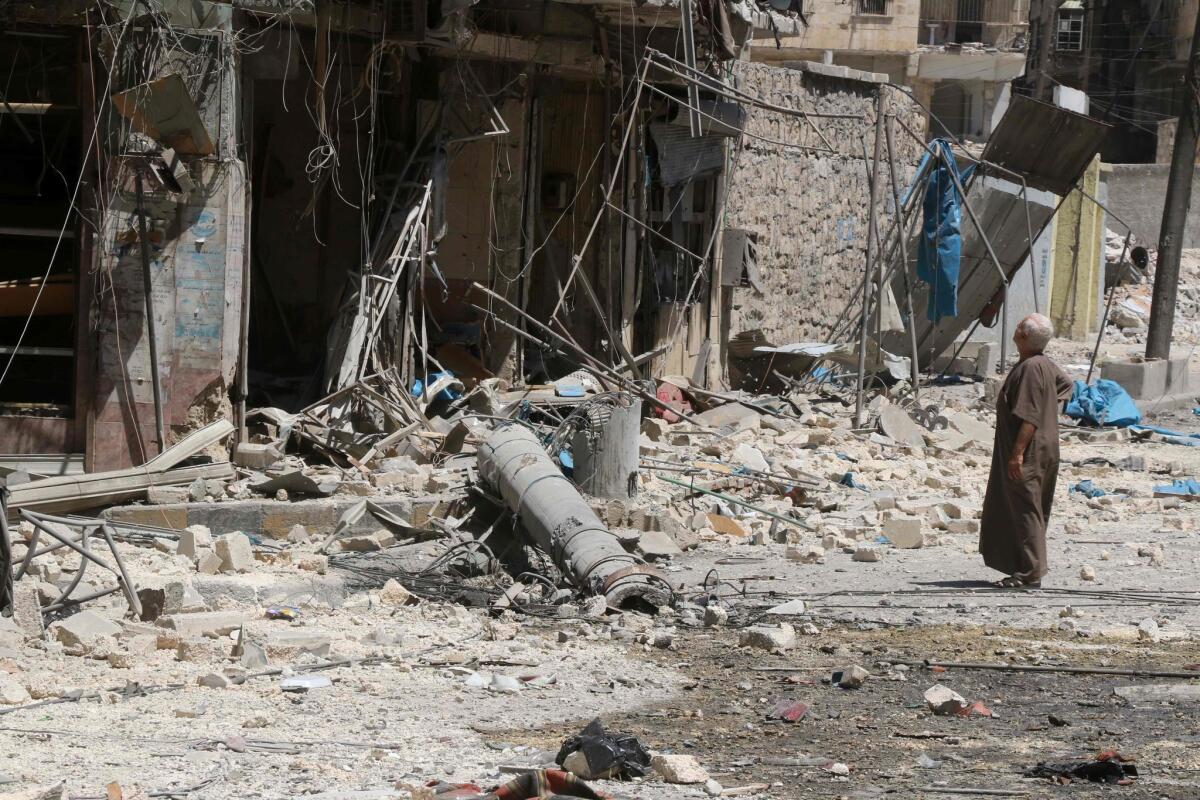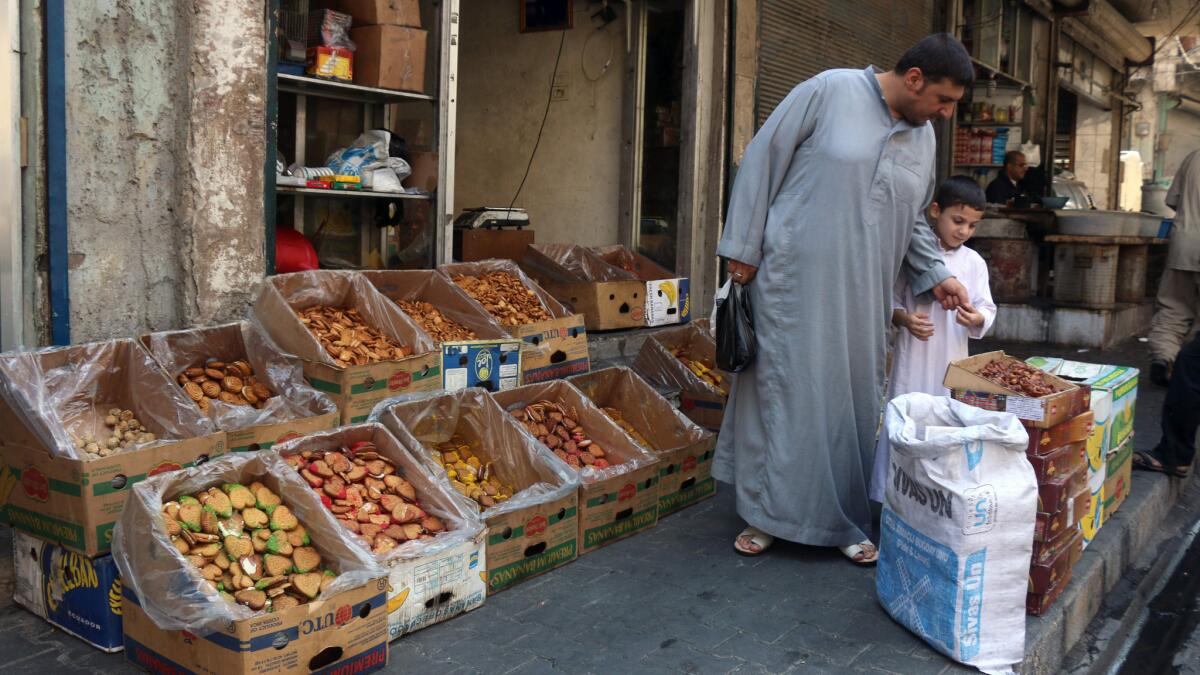Soldiers on both sides see the fight for Aleppo as a battle between jihadists

- Share via
Reporting from Beirut — It was a Saturday evening on June 16, 1979, when a duty officer in the Aleppo Artillery School, Capt. Ibrahim Yousef, called some 300 cadets for an urgent meeting in the mess hall.
After the hall filled, 10 men armed with automatic weapons entered and locked the doors. Like Yousef, they were members of a violent militant group called the Fighting Vanguard that had splintered from the Muslim Brotherhood.
Speaking into a microphone, Yousef announced that “every Nusayri student in this hall is now in the hands … of the Fighting Vanguard,” according to government accounts. Nusayri is a derogatory term for Syria’s Alawite sect, an offshoot of Shia Islam whose members include the family of Syrian President Bashar Assad.
Taking a list from his pocket, Yousef called out the names of those who could leave the hall “because we do not want to hurt our Sunni [Muslim] brothers.”
After the Sunnis left, he and his accomplices opened fire and threw grenades at the remaining students, who were Alawites, killing 32 and wounding 54 others before escaping.
See the most-read stories in World News this hour »
More than 35 years later, the massacre has become an inspiration for Syria’s armed opposition to Assad’s government. Opposition groups announced the “Ibrahim al-Yousef” offensive earlier this month to break the government’s siege on rebel-held eastern neighborhoods of Aleppo, Syria’s largest city.
It was another sign of the cataclysmic sectarian confrontation the battle of Aleppo has become for the rebels arrayed against Assad, not to mention the growing integration of hardcore jihadists in rebel ranks despite U.S. efforts to wean the opposition of them.
Although the five-year civil war in Syria began as anti-government protests, it has devolved into a sectarian bloodbath that has pitted the largely Sunni opposition against forces loyal to Assad, which include Shiites, Druze, Sunnis and Christians. Shiites in Syria, including Assad’s Alawite sect, comprise roughly 13% of the population but long have had an outsized role in state affairs.
The battle has drawn Shiite militias from Lebanon, Iraq and Afghanistan on the side of Assad, even as Sunni would-be jihadists from around the world have filled the ranks of the many Islamist groups fighting his rule, including the Islamic State extremist group.
In the past few weeks, Islamist groups have taken the lead in reversing many of the pro-Assad forces’ hard-won gains in Aleppo, a city divided since 2012 between the government and the opposition. The Army of Conquest, an alliance of hard-line Islamist factions that includes a rebranded former Al Qaeda affiliate, the Front for the Conquest of Syria, spearheaded the offensive.

Its suicide bombers (many of them Syrians instead of the usual panoply of foreigners) were instrumental in punching through the defenses of the Syrian Army; they now threaten to impose their own blockade on the western, government-held part of the city and have vowed to take over all of Aleppo.
The relatively moderate, U.S.-backed Free Syrian Army and other groups “could not achieve any real breakthrough without the jihadis of … the Army of Conquest,” Hassan Abu Haniyeh, a Jordanian expert on jihadi groups, wrote in an article on the online Arabi21 website.
In the offensive’s aftermath, the jihadists touted the victory as their own.
“The Aleppo battle was a truly divine one. … The lions roared, the heroes of this blessed … Army of Conquest,” Abdullah Muhaysini, top cleric of the Army of Conquest, said during filming of the online show “Syria in One Week” inside the ravaged courtyard of the centuries-old Great Mosque of Aleppo.
Beside him, another cleric, Ibrahim Shasho, spoke of how “scores of the young men” had registered to become suicide bombers and prayed that the fighters would “purify the land of Syria from the filth of infidelity and the Shiites and the Nusayris.”
Other groups, including those categorized as moderate by the U.S., had worked with the jihadists to attack from inside the besieged neighborhoods of the city.
“There is a good relationship and coordination among all the factions,” said Capt. Abdul-Razzaq, spokesman of the Nour Din Zinki rebel faction, which until last September was the recipient of U.S. support.
In an interview on social media, he said, “We support unity [with the Army of Conquest] if it is done on good foundations” and serves the aim of “a free Syria.”
Such a move, however, would complicate efforts by the U.S. and Russia, which both have targeted extremists in areas held by groups such as the Front for the Conquest of Syria.
“It underlines the confusion in rebel ranks, where the pro-democratic revolutionary forces are teamed up with Al Qaeda and the West is on the side of Al Qaeda,” said Joshua Landis, a Syria specialist at the University of Oklahoma.
“The fighters on the ground, who have been shopping around for the most effective and appealing group, have gravitated toward [the Front for the Conquest of Syria] and Islamic State. That’s the problem, and most moderate leaders have been trying to put a good face on the jihadi aspect.”
Islamic State is not involved in the battle for Aleppo, although it holds sway in some of its countryside areas. It has formed a third side that has fought both the government and the rebels, despite having an ideology that is similar to some opposition factions.
But for Haniyeh, speaking in a phone interview Tuesday, the battle for Aleppo marks a revival of a Sunni jihad that has no reservations about its sectarian face and no longer is concerned with the approval of Syria’s opposition politicians abroad nor their Western allies.
“There were no objections from the moderate groups regarding the use of Yousef’s name, a sectarian symbol,” Haniyeh said. “There is a jihadi Sunni Arab narrative being formed in Aleppo that uses him, a sectarian symbol, without regard for its international or regional image.”
And even on the homefront, the rebel success has terrified the approximately 1.5 million people living in western, government-held Aleppo.
“Will the jihadists spare the Christians of Aleppo?” Aleppo resident Tony Sakkal asked in an interview with Lebanese newspaper L’Orient Le Jour last week. “Of course not. They’ll cut off our heads.”
Bulos is a special correspondent.
Incendiary weapons that violate international law are being used in the Syrian war, report says
Two years after war, rebuilding in Gaza is far from done, and international donors are bailing
Russian warplanes take off from Iran to target Islamic State in Syria
More to Read
Sign up for Essential California
The most important California stories and recommendations in your inbox every morning.
You may occasionally receive promotional content from the Los Angeles Times.











